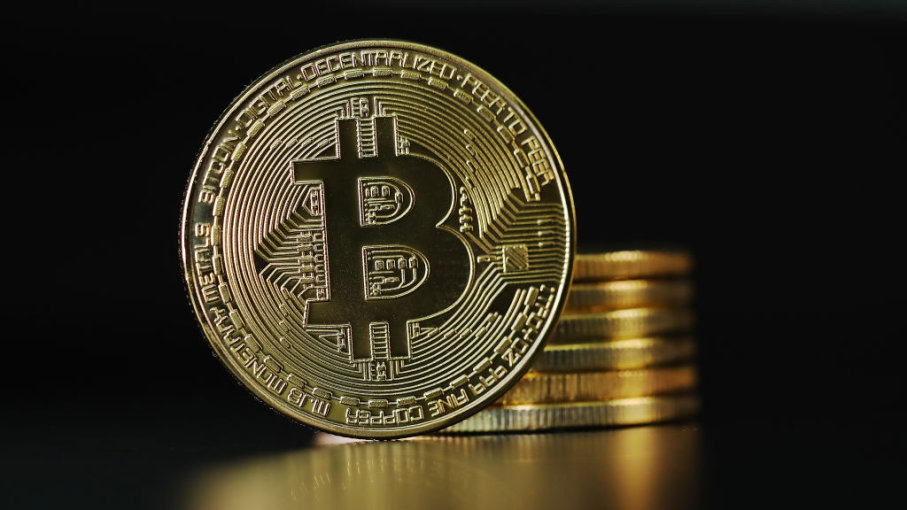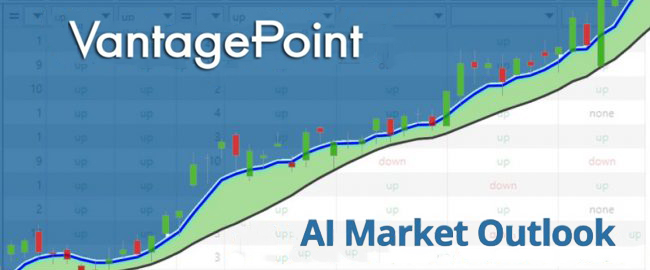Everything You Wanted to Know About Bitcoin* (*but were afraid to ask)
In October 2008, while the economy imploded from the Great Recession an anonymous technologist by the name of Satoshi Nakamoto sent a message to a forum of cryptographic enthusiasts alerting them that he had created a new peer-to-peer money.
This white paper, which has been downloaded millions of times by fans and critics alike, has changed the discourse on what money is and how it affects our ideas of value as we move forward in the digital age.
Almost twelve years later Bitcoin maximalists proclaim that this new cryptocurrency is the answer to all the financial problems associated with fiat currencies which can be printed and debased at will. Furthermore, bitcoin provides its users an opportunity to send money to anyone in the world without needing a trusted middleman to authorize, confirm and verify the transaction. This, in a nutshell, is what makes bitcoin truly revolutionary and disruptive to the entire payments and financial industry.
Critics on the other hand, imply that only governments can create a currency and that Bitcoin is destined to fail because it does not have the right to act in a capacity that has historically been held only by sovereign governments.
Clearly the battle lines have been drawn and the debate rages on.
At the time of this writing, one bitcoin is priced at slightly less than $10,000. It is noteworthy that bitcoin has attained this success purely on word of mouth and without a marketing or public relations department. But, because of these very strong and controversial perspectives surrounding bitcoin, its function and boundaries, it’s very easy to find level-headed analysts who will tell you in the same breath that “bitcoin has the capacity to rise in price to one million dollars in price or be completely worthless in the very near future.” Normally, when something new is created the path forward is obvious. But in the case of digital currency the inventors and the vested financial interests in the government appear to have contradictory aims and objectives.
The history of bitcoin is fraught with intrigue and mystery. A technology rises from the ashes of one of our nation’s largest financial crises. Political idealists project visions of societal liberation upon it while establishment bureaucrats heap contempt and scorn upon it. Technologists on the other hand are transfixed by it, seeing almost unlimited possibilities to change the world.
The simplest way to understand bitcoin is to examine its similarities and differences with traditional payment networks.
For example, when you go to the store to buy something using your normal bank card this is what happens:
-
You give your debit card details to the
-
The vendor electronically asks the bank if you have enough cash in your account to verify that the transaction is good.
-
The bank checks its ledger to verify your account balance.
-
If your bank balance is greater than the purchase you want to make, your transaction is approved and your balance is reduced by your purchase amount and this amount is credited to the vendors account.
-
The bank takes a small percentage fee for its efforts in verifying this transaction.
What makes Bitcoin revolutionary and highly disruptive in this regard was that Satoshi Nakamoto looked at the above process which occurs millions of times a day and asked a simple question:
How could I eliminate the bank middleman from that transaction and still maintain the integrity of the transaction?
In other words, who else would you trust to oversee the records and transactions and not alter them in any way?
Up until the time Bitcoin was invented this was impossible.
Satoshi Nakamoto’s brilliant insight was to remove the bank as a centralized trust authority and instead to create a decentralized ledger referred to as the blockchain, which resides on every computer on the network. These auditors and their computers are called “miners” who verify the integrity of all transactions that occur and get paid a small reward in bitcoin for their auditing efforts. The network of miners establish consensus before a transaction is verified and authorized and posted on the decentralized ledger. This consensus has proven to make bitcoin counterfeit-proof while simultaneously allowing individuals to interact with each other financially without the need of a central authority.
When you begin to comprehend the nature of this accomplishment you will quickly understand that the following five words best describe the phenomena of bitcoin.
Decentralized – it does not have a specific location.
Borderless – without boundaries or restrictions.
Trustless – verification occurs through consensus of all computers on the network, not through a central authority, middleman, personality or political figure.
Value Transfer Network – it transfers value between any two parties anywhere in the world without the permission or interference of any other authority. The amount of time it takes depends on how busy the network is. It can take as long as a day for a transaction to clear and as little as a few seconds.
Currency – a system of money.
The chasm that exists between what the mainstream media believes that Bitcoin is and what technologists claim is enormous. Yet these words best describe the profound implications that bitcoin has created for our current monetary system. More importantly, these words clearly show how antiquated our current digital payment networks are as a comparison.
At its most fundamental level Bitcoin is a breakthrough in computer science as it has created a technological structure to establish verification and trust between unrelated parties over an unsecure and untrusted network like the internet. The powerful consequence from this is that Bitcoin allows one internet user to transfer a digital property to another internet user in a manner that is safe, secure, can be verified and anyone can observe the legitimacy of the transfer. All of this occurs in a manner where only the owner of an asset can send it, and only the recipient can receive it, yet everyone if they choose to can validate the integrity of the transactions. And to top it all off, bitcoin accomplished all of this for substantially less cost than what the current trusted authorities and middlemen like banks charge for their services.
In a digital society, the majority of payments are made via the web by means of a middleman related service: a credit card company like Amex, Visa, or Master Card or a digital payment provider such as PayPal, GooglePay or Apple Pay, or an online platform like WeChat in China. Traditionally moving towards digital payments brings with it the reliance on a central figure or entity that has to approve and verify every payment. This is what has occurred naturally as the world economy has moved from cash which you can carry, transfer and verify yourself, to digital bits that are stored and verified by a third party. It is worth thinking about the cost of this convenience as technologists would warn us that, unless we are careful, we are also providing extraordinary powers to those who could potentially oppress us. This has occurred already in countries like China where political dissidents are banned from being able to make or receive digital payments.
Over the years there has been a lot of discussion in the Crypto community about the possibility of Bitcoin being banned by governments. This perspective is often presented because of how bitcoin operates outside the traditional banking system. However, bitcoins fundamental design is such that it is very difficult to ban. As long as someone has an internet connection and a Bitcoin wallet, they can engage in Bitcoin. Try as they might, Bitcoin can’t be pushed away just because it threatens the financial power structure. This is also one of the uniquely powerful qualities of bitcoin. Furthermore, it has a market capitalization of roughly 180 billion dollars which is larger than the existing money supply of many industrial countries.
This truly is a remarkable innovation that has tremendous implications for commerce, politics and monetary systems around the world.
Since Bitcoin consists of a transparent distributed ledger (the blockchain), it has become a source of tremendous innovation around the world. Sending someone Bitcoin is as easy as sending an email. More importantly, there is no authorization required and, in many cases, either no fees or very low fees for creating the transaction.
Currently, about 300,000 transactions occur on the Bitcoin network every day. Never before in history have we been able to send small amounts of value, sometimes down to a few pennies to anyone in the world. Existing payment networks charge additional fees between 2% and 5% in the developed world with a corresponding amount charged for every transaction that occurs.
For example, it is quite common for a small business that is processing credit card transaction to pay over 50 cents per each transaction on top of whatever finance charge is agreed upon. In many areas of the world credit card fraud risk is so high that merchants will not accept transactions from certain regions because of the high chargeback and fraud ratios. Bitcoin changes all of this and permits commerce to occur where once it could not.
Bitcoin allows for nano microtransactions to occur which allows content and media to be monetized for very small financial amounts. We’re talking amounts of less than five cents which has never been available till today.
That last part is enormously important and speaks to the heart of why Bitcoin has captured the imaginations of many entrepreneurs online. Some businesses operate on very small profit margins. When they do the math and realize that they are paying 2% to 5% or more to a bank, they realize that the way they are conducting their affairs is counterproductive. If they transact with Bitcoin and save that 2% to 5% those funds can be reinvested in their businesses, passed back to consumers or even possibly taxed by the government. Working with the traditional payment networks of yesteryear clearly is the worst option in this regard.
Bitcoin is by far a more productive and efficient means of transferring value between parties. If you question this, simply go to a bank and try to transfer a small amount of money to somebody somewhere else in the world. What you will encounter is huge transaction fees, lengthy time delays, horrible exchange rates and a lack of comprehension why a cash transfer between two parties can take over a week to arrive at its destination.
Or have you ever tried to use an international ATM? You end up paying very high service fees to access your money! Or worse yet, in many international nations you cannot access your funds through the nation’s ATM network.
Critics of Bitcoin point to its historical volatility and question its store of value since it has been known to lose more than 25% of its price in a single day. While this is true, supporters of Bitcoin claim that this volatility is the result of “growing pains” as well as the reality that enemies of bitcoin often engage in very aggressive short selling to discourage more supporters from entering the marketplace.
Bitcoin can be used entirely as a payment system; merchants do not need to hold any Bitcoin currency or be exposed to Bitcoin volatility at any time as they can immediately convert their bitcoin to the currency of their choice. Any consumer or merchant can trade in and out of Bitcoin and other currencies any time they want. Also, merchants are attracted to Bitcoin because it eliminates the risk of credit card fraud or the theft of credit card information from a merchant’s computer server. This is the form of fraud that motivates so many criminals to put so much work into stealing personal customer information and credit card numbers.
You might remember a few years ago that the retailer Target was breached, with a huge hack that stole 70 million consumers’ credit card information.
Here is how a Bitcoin merchant transaction could look like:
You go to the checkout station but instead of handing over your credit card to pay, you use your smartphone and take a snapshot of a QR code displayed by the cash register. The QR code would include all the information necessary for you to be able to send Bitcoin to Target. You simply then click “Confirm” on your phone and the transaction is done (including converting dollars from your account into Bitcoin).
Target is thrilled because it has the money in the form of Bitcoin, which it can immediately convert into dollars if it so chooses, and it paid very low payment processing fees. You are happy because there is no way for hackers to steal any of your personal information; and identity theft becomes an impossibility.
It is important to address the criticisms related to Bitcoin being a haven for criminal behavior. Mostly this is a myth created by sensationalized media coverage. It is true that criminals could use Bitcoin as easily as they have used cash in the past. But the difference is that, like email, which is traceable, Bitcoin is not anonymous but rather pseudonymous. Since every transaction is logged on the network forever, it is very easy for law enforcement to trace bitcoin addresses and capture criminal behavior. As a matter of fact, there are numerous cryptographic forensic services dedicated to helping law enforcement determine who owns certain bitcoin addresses.
What is very exciting and promising about Bitcoin is that it can be a major force for good to bring a large number of “unbanked” people in the world into the modern economic system. Roughly 30% of the world’s population does not even have a bank account. Bitcoin is acting as a catalyst through its global payment features to allow anyone to engage financially with anyone else. Since Bitcoins have a powerful property of almost infinite divisibility, down to eight decimal places, which opens commerce for sections of the world that have been too poor to participate in modern commerce.
What’s the future of Bitcoin?
I think our current economic headlines address why Bitcoin has become very popular among sections of our population. At the time of this writing, 46 million unemployed, which is larger than the entire population of Canada.
Here is a chart of the current value of $1.00 since 1913 when the Federal Reserve Bank began managing the economy. You can see that without exception the value of the currency has been debased better than 90% of the time.
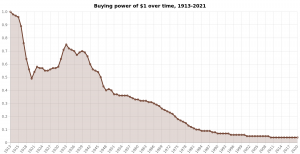
Value of $1.00 from 1913 to 2020
Bitcoin offers tremendous hope and promise for improving problems in our world by reinventing how the financial system can work in the digital age. No longer can we afford to embrace antiquated systems that worked in an era before our technology took center stage and leveled the playing field in so many respects.
Lastly, PRICE is the only thing that will make you RICH or POOR. And it is these price changes correlated to the asset classes which are most statistically relevant which are responsible for creating these trend forecasts which have proven to be 87.4% accurate. Bitcoin, because of its volatility can be a tremendous trading vehicle as well. Currently futures contracts trade on the Chicago Mercantile Exchange and speculators can purchase smaller custom sized lots on their favorite cryptocurrency exchange.
If you pull up a chart of Bitcoin, you are looking at it in complete ISOLATION. You are not taking into account any of the key drivers which affect its price:
- or the volatility of the Chinese Yuan currency
- or Crude Oil Prices
- or the NASDAQ
- the value of the US Dollar
- or Interest Rates
All of those factors are key drivers to the price movement of Bitcoin.
This is because markets are globally interconnected.
Here is a graphic of the current, most statistically correlated drivers of Bitcoins price.
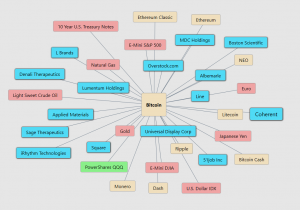
Key Drivers of Bitcoins Price
Once you know what the key drivers of an asset are, the artificial intelligence can very accurately forecast the price 1 to 3 days in advance with up to 87.4% accuracy, which makes trading opportunities crystal clear.
The beauty of artificial intelligence is that it looks at these global correlations for each asset statistically to uncover the risks and rewards within the trends.
The tools most traders are using rely on single market analysis, which puts them at a horrible disadvantage. This creates timing problems, bad trade selection and lack luster results.
Simply look at how the Bitcoin chart comes to life with the Vantagepoint artificial intelligence forecasts.
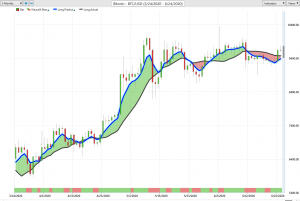
Bitcoin With Vantagepoint A.I. Forecasts
That should get you pretty excited because it is a game changer!
What’s Your Best Chance To Make Money In The Financial Markets Today?
The Answer A.I. offers will surprise you.
Intrigued?
Visit with us and check out the a.i. at our Next Live Training.
Discover why artificial intelligence is the solution professional traders go-to for less risk, more rewards, and guaranteed peace of mind.
It’s not magic. It’s machine learning.
Make it count.
[/fusion_text][/fusion_builder_column][/fusion_builder_row][/fusion_builder_container]





